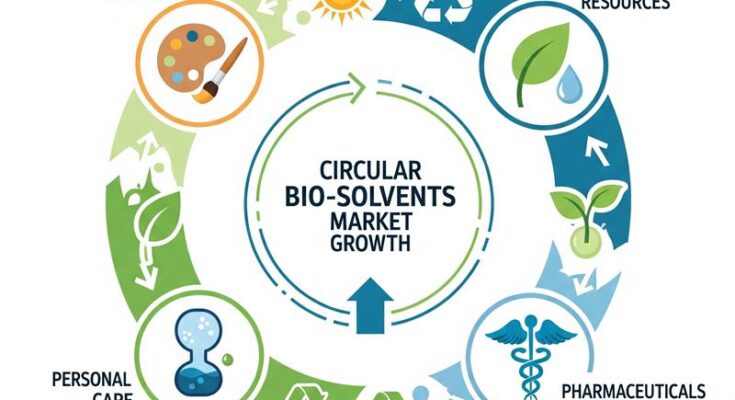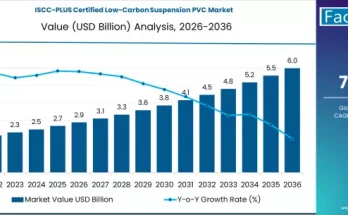The global circular bio-solvents market is expected to reach USD 2,149 million by 2035, up from USD 1,014 million in 2025. During the forecast period from 2025 to 2035, the industry is projected to expand at a compound annual growth rate (CAGR) of 7.8 percent. This impressive expansion is being fueled by sustainability commitments, government support for circular practices, and growing awareness among industries and consumers about the need for safer and eco-friendly solvents.
Market Segmentation by Type
The market can be segmented into bio-alcohols, bio-glycols, bio-diols, bio-based esters, bio-based ketones, and other niche products. Among these, bio-alcohols such as ethanol, butanol, and isopropanol currently dominate due to their wide availability, strong solvency power, and lower toxicity compared to conventional petrochemical solvents. Bio-glycols and bio-diols are gaining momentum as they provide versatile applications in coatings, adhesives, and cleaning agents. Meanwhile, bio-based esters and ketones are gradually carving out a place in specialty markets where biodegradability and performance advantages are valued.
Feedstock and Application Landscape
Feedstock selection plays a crucial role in shaping the market. While first-generation feedstocks derived from food crops were once prevalent, second-generation options made from non-edible biomass, agricultural residues, and forestry waste are increasingly preferred. These alternatives not only reduce competition with food supply but also support the principles of a circular economy by valorizing waste. In the longer term, third-generation feedstocks such as algae and other advanced bio-resources hold promise for scaling the market sustainably.
Applications of circular bio-solvents are diverse, spanning paints and coatings, adhesives and sealants, pharmaceuticals and cosmetics, industrial and domestic cleaning, printing inks, and agrochemicals. Demand is especially strong in paints and coatings, where low-VOC and biodegradable formulations are highly sought after, and in cleaning products, where eco-friendly credentials are becoming a strong consumer requirement.
End-Use Industries Driving Demand
Several industries are at the forefront of adopting circular bio-solvents. Automotive manufacturers are turning to bio-based coatings and cleaning agents to meet both regulatory standards and customer expectations. The construction sector increasingly uses solvent systems with reduced environmental impact. Healthcare and personal care companies are embracing bio-solvents for cosmetics and pharmaceutical formulations, while the agriculture sector is incorporating them into safer, greener crop protection solutions. Packaging and printing are also adopting bio-based solvents to align with sustainability goals and enhance recyclability.
Regional Dynamics
Regional variations are shaping the market landscape. Western Europe remains a leader thanks to strong regulations, infrastructure for recycling, and a supportive policy framework under the European Green Deal. Germany in particular stands out for its adoption of circular practices across industries. In Asia-Pacific, countries like China and India are emerging as fast-growing markets due to abundant agricultural residues, large-scale industrial demand, and supportive government initiatives. India is expected to register one of the fastest growth rates, reflecting its focus on developing a bio-based economy. North America also shows steady expansion, driven by technological innovation and rising consumer awareness.
Recent Developments and Innovations
Recent years have seen a wave of new product launches and facility expansions that demonstrate how the market is evolving. In May 2024, Caldic Europe expanded its circular solvent offerings by introducing sustainable ethyl proxitol in partnership with a major chemical producer. Earlier in 2023, a leading specialty chemicals company invested in Italy to establish a new production unit for highly dispersible silica derived from rice husk ash. This process not only reduces carbon emissions but also exemplifies how agricultural waste can be transformed into valuable industrial inputs. These developments signal a broader trend: companies are moving beyond incremental product improvements and embedding sustainability into their entire supply chains.
Key Players and Competitive Landscape
The competitive environment includes global giants and specialized bio-chemicals firms alike. Established players such as BASF, Dow, ADM, Cargill, Eastman Chemical, LyondellBasell, Solvay, Clariant, Croda International, AkzoNobel, and Huntsman continue to dominate through their global reach and broad product portfolios. At the same time, niche players like Vertec BioSolvents and regional innovators are carving out spaces with specialized, sustainable offerings. Competition is increasingly centered around innovation in feedstock sourcing, efficiency of conversion technologies, and the ability to offer cost-effective products that match or exceed the performance of petrochemical alternatives.
Challenges and Restraints
Despite strong momentum, several challenges remain. High production costs still limit the widespread adoption of bio-solvents, especially in price-sensitive markets. Ensuring consistent and scalable supply of waste-based feedstocks can also be difficult, as availability varies with season and geography. Technological barriers persist, particularly in achieving high yields and purity in advanced conversion processes. In some regions, regulatory frameworks are underdeveloped, which can slow industry adoption. Finally, market acceptance can be a hurdle, as some industries remain cautious about switching to alternatives that may be perceived as costly or unproven.
Strategic Insights
To succeed in this competitive environment, companies are focusing on several key strategies. Securing reliable and sustainable feedstock supplies is essential to reduce costs and enhance credibility. Innovation in bio-refinery and process technologies helps boost efficiency while lowering carbon footprints. Building partnerships across industries—linking chemical producers with agriculture, waste management, and biotechnology firms—is proving valuable in scaling circular practices. Aligning products with evolving regulatory standards and sustainability certifications further strengthens market positions. Geographic expansion into regions with strong feedstock availability and supportive policies also offers significant opportunities.
Conclusion
The global circular bio-solvents market is poised for significant growth in the decade ahead, more than doubling in value by 2035. While bio-alcohols currently dominate, other product categories are gaining traction, driven by demand for safe, sustainable, and high-performance alternatives. Key industries including automotive, healthcare, construction, and agriculture are rapidly adopting bio-solvents, while innovations in feedstock sourcing and production methods are reshaping competition. Though challenges remain in cost, supply, and awareness, the overall outlook is highly positive. Companies that integrate sustainability throughout their operations, build strong collaborations, and continue to innovate will be best positioned to lead in this dynamic and fast-growing market.



